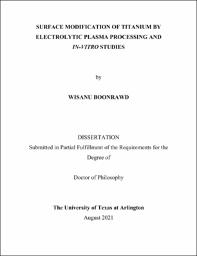
ATTENTION: The works hosted here are being migrated to a new repository that will consolidate resources, improve discoverability, and better show UTA's research impact on the global community. We will update authors as the migration progresses. Please see MavMatrix for more information.
Show simple item record
| dc.contributor.advisor | Meletis, Efstathios I | |
| dc.creator | Boonrawd, Wisanu | |
| dc.date.accessioned | 2021-09-14T15:32:07Z | |
| dc.date.available | 2021-09-14T15:32:07Z | |
| dc.date.created | 2021-08 | |
| dc.date.issued | 2021-08-02 | |
| dc.date.submitted | August 2021 | |
| dc.identifier.uri | http://hdl.handle.net/10106/29998 | |
| dc.description.abstract | Electrolytic plasma processing (EPP) can be operated in two modes, namely plasma electrolytic saturation (PES) and plasma electrolytic oxidation (PEO). In this study, the PES was used to create hydrophilic surface profiles on titanium (Ti). The wettability, surface morphology characteristics and chemical composition of the treated samples were studied as a function of PES processing parameters. The PES profiled surfaces comprised of a characteristic “hills and valleys” morphology because of continuous surface melting and freezing cycles. A bimodal surface profile was produced with 2-3 µm height hills and valleys with nano-roughness (≤ 200 nm). The produced profile resulted in a significant contact angle decrease (from 38.7° to 5.4°). Ratios of actual surface area to projection area (r) and fraction of solid surface remaining dry were obtained from profilometry. The surface characteristics and large r values produced by PES were able to induce hemi-wicking. Hence, PES produced superhydrophilic surfaces on Ti. The bioactivity of PES treated Ti was evaluated using cell free and MC3T3 cells in-vitro studies. The treated Ti surface significantly increased the bioactivity and formed stoichiometric hydroxyapatite after immersion in a bone cell culture medium for 21 days. Cells’ attachment and proliferation studies indicated that PES treated surface significantly enhances the cells’ adhesion and growth after 24 and 48 hr compared to the untreated surface. The results show that Ti surface profiling by PES constitutes a promising method to potentially improve bone implant bonding.
PEO was used to produce titanium oxide (TiO2) coatings on Ti surface in potassium – phosphate electrolyte. The morphology, wettability, phase, and chemical compositions were studied as a function of processing parameters. The bioactivity of the coating was assessed by the ability to form biomimetic apatite in-vitro using cell culture medium. In-vitro studies using human mesenchymal stem cells were also conducted to evaluate cells’ proliferation and viability of the treated Ti. The results revealed that the produced TiO2 coatings comprised pore features with the pore size increasing with applied current density and treatment duration due to high energy discharge channels at higher potential. The PEO treated Ti exhibited superhydrophilic characteristics with a contact angle <1o. The findings indicated that the large actual surface area produced by the PEO treatment and the presence of negatively charge are the key factors for the superhydrophilic behavior. The in-vitro studies revealed that the PEO treated groups had higher amount of biomimetic apatite formation compared to the as-polished Ti. The PEO treatment significantly enhanced the cells’ adhesion and growth after 24 and 72 hrs compared to the untreated Ti. A significant difference in the bioactivity was not observed between anatase and rutile. | |
| dc.format.mimetype | application/pdf | |
| dc.language.iso | en_US | |
| dc.subject | Titanium | |
| dc.subject | Hydrophilicity | |
| dc.subject | Hydroxyapatite nucleation | |
| dc.subject | Surface roughness | |
| dc.title | SURFACE MODIFICATION OF TITANIUM BY ELECTROLYTIC PLASMA PROCESSING AND IN-VITRO STUDIES | |
| dc.type | Thesis | |
| dc.degree.department | Materials Science and Engineering | |
| dc.degree.name | Doctor of Philosophy in Materials Science and Engineering | |
| dc.date.updated | 2021-09-14T15:32:07Z | |
| thesis.degree.department | Materials Science and Engineering | |
| thesis.degree.grantor | The University of Texas at Arlington | |
| thesis.degree.level | Doctoral | |
| thesis.degree.name | Doctor of Philosophy in Materials Science and Engineering | |
| dc.type.material | text | |
| dc.creator.orcid | 0000-0002-9396-7346 | |
Files in this item
- Name:
- BOONRAWD-DISSERTATION-2021.pdf
- Size:
- 49.80Mb
- Format:
- PDF
This item appears in the following Collection(s)
Show simple item record


